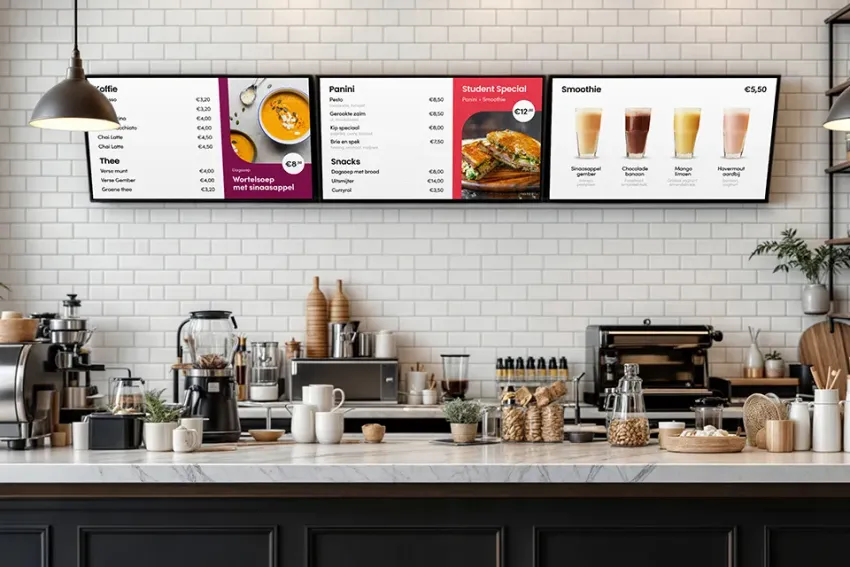Dynamic pricing: more than just a trend
Dynamic pricing is gaining ground in the catering industry, offering new opportunities to boost revenue and enhance the customer experience. By adjusting your prices based on factors like demand, season, or time of day, you can respond more intelligently to changing conditions. Discover how you can implement this strategy in your business.
What is dynamic pricing?
Traditionally, hospitality businesses use fixed, static prices: a cappuccino costs the same today as it does tomorrow, regardless of the time or circumstances. Dynamic pricing breaks away from that idea by adjusting prices flexibly based on real-time factors.
Think of how airlines or hotels work: the price of a ticket or room constantly fluctuates. In hospitality, this means a product or dish could be slightly cheaper during quiet hours and cost a bit more during busy periods.

Uni Signage, digital pricelists
The Benefits of Dynamic Pricing
1. Increase revenue with discounts at the right time
The biggest advantage of dynamic pricing is that it allows you, as a hospitality entrepreneur, to better manage demand and optimize your revenue. During off-peak hours, you can offer lower prices or special discounts, attracting guests who might not have visited otherwise. This leads to a more balanced flow of customers and more consistent turnover throughout the day.
2. Boost your margins during peak hours and seasonal demand
During busy periods, you can apply slightly higher prices when demand is naturally high. This keeps your margins healthy, even as costs rise. Dynamic pricing can also be seasonal: summer cocktails in July can be priced higher than in January, while hearty stews or mulled wine become more appealing (and profitable) during the colder months.
3. Respond to external factors
- External factors also play a major role. One of the most important being the weather. On a hot summer day, soft drinks might be priced slightly higher, while rainy weather could trigger promotions on comfort food or warm drinks. Experiencing more 🔗 no-shows due to an incoming storm? Dynamic pricing helps you adapt on the fly.
- Ingredient costs can fluctuate too: when raw materials become more expensive, dynamic pricing allows you to offset part of that increase.
- Competition is another key factor: if the place next door launches a big discount, you can react instantly without being locked into outdated price agreements for weeks.
For customers, dynamic pricing is often positively received when it’s presented as an advantage. A digital price display might show:
“Today: 20% off all pizzas between 3 PM and 5 PM.”
Transparency and framing your adjustments as customer benefits are crucial to maintaining trust and engagement.
Challenges
1. Transparency is key
Dynamic pricing isn’t without its pitfalls. Customers may feel disadvantaged if they suddenly pay more for the same product than they did the day before, especially if the reason isn’t clear. That’s why transparency is essential: clearly explain why prices fluctuate and emphasize the benefits for the customer.
2. Investment
Dynamic pricing requires an upfront investment in the right technology. It involves continuous monitoring and a system that can automatically adjust prices, doing it manually is simply not feasible. Without digital tools such as 🔗 websites and apps, 🔗 QR codes, and 🔗 digital displays, it becomes difficult to make changes clearly and accurately.
Your staff also needs to be on board, so they can confidently explain the concept to customers.
How to implement dynamic pricing
1. Happy hour
In practice, dynamic pricing often starts small. Happy hour promotions and time-based discounts are perfect examples, fixed discounts during quiet hours that customers naturally associate with value. From there, you can gradually expand into more sophisticated strategies.
2. Digital menu pricing
Digital menus through 🔗 apps or 🔗 QR-code ordering make it easy to always show customers the correct price, without the need to constantly reprint physical menus whenever prices change.
3. Digital price displays
🔗 Uni Signage, Unipage’s digital price display system, offers an extra advantage. These in-store screens let you dynamically showcase prices, promotions, and special offers. Every guest instantly sees what’s happening, whether it’s happy hour, a rainy-day discount, or a premium price on a Saturday night.
4. Loyalty programs
Dynamic pricing can also be integrated into loyalty systems. Imagine loyal customers receiving extra discounts during off-peak hours or gaining exclusive access to seasonal promotions.
Examples include:
“Loyalty members get €2 off all pastas every Wednesday,”
or
“Earn double points during quiet afternoon hours.”
This combines price flexibility with customer retention, rewarding loyalty while managing demand.
Dynamic prices: smarter and more flexible
Dynamic pricing isn’t a threat to the hospitality industry, it’s an opportunity to respond to supply and demand in a smarter, more flexible way. When applied transparently and thoughtfully, customers see it as a benefit, and it increases both revenue and satisfaction.
Unipage supports hospitality entrepreneurs in this process with POS systems, webshops, ordering apps, QR-code solutions, and digital displays like Uni Signage. This makes implementing dynamic pricing not only feasible, but also clear, efficient, and customer-friendly. With the right tools, you can start today with a dynamic pricing strategy that makes your business future-ready.
Want to learn more? 🔗 Get in touch with one of our experts or request a demo below 👇.
Request a demo
We will contact you within 24 hours for a demo